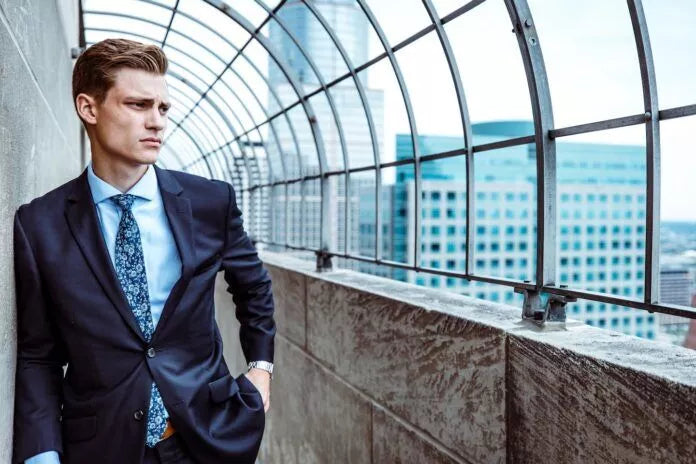Business-casual, like smart-casual, is one of the many dress codes that have caused confusion before doing anything to bring comfort, according to Josh Sims, the author of Men of Style. However, it played a positive role in changing the perception of how men should dress in white-collar workplaces, especially since the tech boom and the breakdown of office dress codes in recent decades.
THE BIRTH OF BUSINESS-CASUAL
Business-casual was first introduced in the 1980s in Silicon Valley. The concept was born in small, self-contained tech companies that valued results over process and spent more time in front of screens than with people. The idea behind business-casual was to create a work culture that was inclusive and non-threatening. The dress code allowed employees to dress down on Friday, thus creating a sense of equality among coworkers, even if the boss was still better dressed on other days. The traditional suit was replaced by khakis and polo shirts.
THE ORIGIN OF CASUAL FRIDAY
Casual Friday has roots that can be traced back to the 19th century when British workers wore tweed suits before heading to their country estates for the weekend. The concept of in-office informality was further reinforced by the 1966 creation of “Aloha Fridays” by the Hawaiian Fashion Guild.
DOCKERS’ GUIDE TO CASUAL BUSINESS WEAR
In 1992, the marketing department at Dockers, an American workwear brand, sent its guide to casual business wear to 25,000 HR managers. This guide helped to clarify the concept of business-casual, but it was still confusing in 1995 when the Chicago Tribune declared: “Welcome to the confusing world of business-casual.”
DEFINING BUSINESS-CASUAL FOR MEN Business-casual in its strictest sense has been a mixed bag, according to Sims. It simply replaced one uniform (the suit) with another uniform of polo shirts and chinos. However, business-casual has become all-pervasive due to California’s status as a clothing and culture manufacturer, and the perception that tech companies were cutting-edge. Other companies quickly followed the trend, eager to look hip and adopt best business practices.
BUSINESS-CASUAL TAKES OVER
Today, business-casual has taken over the world. In 2017, members of parliament at the House of Commons were allowed to wear “businesslike attire” that didn't have to include ties. The dress code for leaders at the G8 summit in 2013 was “smart-casual.” Banks like JP Morgan have also embraced business-casual, despite employee concerns that they may look unprofessional. Goldman Sachs recently instituted a “casual” dress code for its tech staff, but with the caveat that they must exercise judgement and wear business attire if they have a client meeting.
A WORKING DEFINITION OF BUSINESS-CASUAL
The non-conformist era of business-casual can be defined as demonstrating creativity and enhancing one’s personal brand while still showing respect for one's position, other people, and oneself.
BUSINESS-CASUAL STYLE TIPS
A blazer worn as a separate is less formal than a full suit, but it's still important to aim for something more relaxed, such as an unstructured blazer with little or no padding in the shoulder. Brands like Boglioli, Barena, and Aspesi have perfected this style, but you can also find solid examples at the premium end of the high street
SMART-CASUAL OUTFITS
The components of a smart-casual outfit are like a DJ's mixing console levels. Dial down some items if others are turned up to balance it all, but not too far to be out of harmony. A blazer, shirt, brogues can be too smart, but with a bomber, T-shirt, trainers, tailored trousers will balance it. Swap a shirt for a T-shirt or brogues for trainers to adjust the balance. Avoid thin, shiny materials for separate tailored trousers. Textured, beefier, non-suit-like materials are better for wearing with casual pieces like denim. Chinos are between trousers and jeans, flat front, roll-ups are casual, pleats and creases are smarter. Jogger-style drawstring waist chinos are casual, contemporary, and comfortable. Dressy joggers with a tailored waistband, no cuff, pleats, or creases are safe with actual trousers.
JEANS IN BUISNESS CASUAL
Jeans are casual, but dark (smart) and undistressed jeans are acceptable in a smart-casual workplace. Dark blue unwashed selvedge denim is usually recommended, but black is smarter with tonal stitching and rivets. Clean, modern jeans with minimal detailing are best. Turn-ups make jeans and outfits casual.
FOOTWEAR IN BUISNESS CASUAL
Smooth, shiny, and sleek shoes are smarter, brogues are smart-casual, and chunky Derby is contemporary. Dress trainers with dark leather and white soles are smart if clean. Sleek trainers without chunky branding or stitching are smart-casual.
ACESSSORIES IN BUISNESS CASUAL
A soft leather briefcase works with any look, but a dark-colored grown-up leather backpack is better than a messenger bag. Hybrid carriers that switch between styles are options. A metal bracelet watch elevates any casual ensemble, a Milanese mesh strap has a similar effect.
MENS SMART CASUAL ATIRE
Smart-casual attire can be compared to the levels on a DJ's mixing console. To achieve the perfect balance, some elements should be dialed up while others should be dialed down, but not so much that they are out of harmony. For instance, if you are wearing a blazer, shirt, and brogues, wearing tailored trousers might take your outfit too far towards the smart side. However, if you opt for a bomber jacket, T-shirt, and trainers, wearing tailored trousers will keep the outfit from looking too casual. You can adjust the balance by swapping the shirt for a T-shirt or the brogues for trainers.
When it comes to tailored trousers, be mindful of the material used. It's best to avoid trousers made from thin or shiny material and instead opt for something more textured and less suited to casual pieces and fabrics, such as denim. Chinos are a smart-casual option that fall between trousers and jeans. A flat front and roll-ups give a more casual feel, while pleats and creases make the outfit appear smarter. Tapering the pants will prevent them from looking too dad-like. With the rise of athleisure, you can now find trousers and chinos with a jogger-style drawstring waist, making them more casual, contemporary, and comfortable. These work best with an untucked shirt, polo, or T-shirt. On the other hand, there are also dressier joggers that resemble trousers with a tailored waistband, no cuff at the ankle, and pleats or creases, but these are best reserved for offices with a lax dress code.
When it comes to footwear, the smoother, shinier, and sleeker the shoe, the smarter it is. Brogues are a smart-casual option, while a chunky Derby can look more contemporary. Trainers can be tricky in a smart-casual setting, but there are now more "dress" trainers available that have a dark leather upper with a white sole. White sneakers can look smart if they are clean. Styles with minimal branding and stitching are the best options for a smart-casual look.
BUISNESS CASUAL ACESSORIES
For carrying essentials, a soft leather briefcase works with any of the above looks. In a smart-casual workplace, a backpack is more on-message than a messenger bag. Look for a grown-up option in a dark color, perhaps in leather, with sturdy zips for added smartness. There are also hybrid carriers available that can switch between different styles or be carried by a top handle to resemble a briefcase or tote bag.
Finally, a handsome watch with a metal bracelet will elevate any dressed-down ensemble, even T-shirt and jeans. A metal bracelet is sportier and more casual than a leather strap, and the expanse of shiny metal will add needed sheen to an informal outfit. A Milanese mesh strap sits between a bracelet and leather strap in terms of smartness and will have a similar effect. Regardless of the type of wrist candy you choose, it should have a quartz mechanism.
COMMON BUISNESS CASUAL DO'S AND DONTS
DO: Wear Workwear - Dress in a manner appropriate for work. Jeans are acceptable in most casual work environments but should still be well-cut and in good condition.
DON’T: Wear Just Workwear - Avoid worn, shabby or unstylish jeans. Consider chinos or trousers instead.
DO: Be All Business - Opt for more formal pieces like trousers or shoes over trainers if unsure. It's easier to dress down than to dress up.
DON’T: Be All Casual - Avoid dressing too casually as it may give the wrong impression.
DO: Dress Appropriately - Consider the type of business and dress accordingly. A start-up may be more relaxed than a law firm.
DON’T: Dress Like a Worker Drone - Avoid a traditional suit, shirt and tie. Dress according to your personal style within the bounds of business-casual.
DO: Nail Your Presentation - Keep casual pieces like T-shirts and trainers in good condition and free from stains.
DON’T: Get Ink on Your Sleeve - Avoid exposing tattoos in professional settings.
DO: Mix Textures - Experiment with different fabrics to create a more casual look. Matte fabrics tend to look more casual than smooth and shiny fabrics.
DON’T: Mix Business & Athleisure - Avoid workout clothing in a business-casual setting.
DO: Change Your Working Patterns - Experiment with different patterns to create a more casual look.
DON’T: Wear Pinstripes - Pinstripes are typically seen as too formal.
DO: Check Your Schedule - Consider the level of formality required for your schedule and adjust your attire accordingly.
DON’T: Take a Casual Approach - Avoid dressing too casually as it may lower productivity and give the wrong impression.
DO: Add Attachments - A good watch and leather bag can add some polish to a casual outfit.
DON’T: Slide Down the Corporate Ladder - Avoid flip flops and other overly casual footwear in a professional setting.
5 Key Business-Casual Pieces
- Chinos - Chinos are a mainstay in business-casual attire. Opt for darker colors, creased middle and trouser-style tab closure for a dressier look.
- Unstructured Blazer - An unstructured blazer is more casual than a suit, and soft, nubby or knitted versions are even more relaxed.
- Dress Shirt - Dress shirts in matte fabrics and different colors can add a pop of personality to your look.
- Leather Loafers - Leather loafers are a good choice for shoes as they are comfortable and versatile.
- Wool Trousers - Wool trousers are a good alternative to chinos for a more formal look.
UNCONSTRUCTED BLAZZER
The unstructured blazer is a key component of modern business-casual attire. Ditching the rigid structure of traditional suits, unstructured blazers are soft and relaxed, providing a smart and professional look even when paired with casual items like T-shirts, jeans, and trainers. Made from nubby or knitted materials or even sweatshirt-style jersey, they are more like a jacket than a tailored piece, making them a versatile addition to any wardrobe.
OXFORD BUTTON DOWN SHIRT
The Oxford button-down shirt is another must-have for a business-casual look. Soft collared and with a button-down front, it pairs perfectly with chinos or jeans, giving a smart yet relaxed appearance. It's important to choose the right collar size and shirt length, as too narrow a collar may not accommodate thicker ties, and too short or long tails can impact the overall look.
POLO SHIRT
The polo shirt is a classic staple of business-casual attire, though it has acquired an unfair reputation as the ill-fitting uniform of middle managers. Collared and partly buttoned, it strikes a balance between a business shirt and a casual tee. Long sleeves and refined fabrics like merino wool can elevate the polo to a more office-appropriate look, while logos should be kept minimal and discreet.
SMART TRAINERS
Smart trainers, or sneakers, have come a long way since the days of "econo-brand athletic sneakers". With sleek designs, dark leather or suede uppers, and a clean profile, today's smart trainers can look just as professional as a proper shoe. Choosing trainers without the telltale white rim further elevates their sophisticated appearance.
In conclusion, unstructured blazers, Oxford button-down shirts, polo shirts, and smart trainers are all essential items for a stylish and professional business-casual wardrobe.




